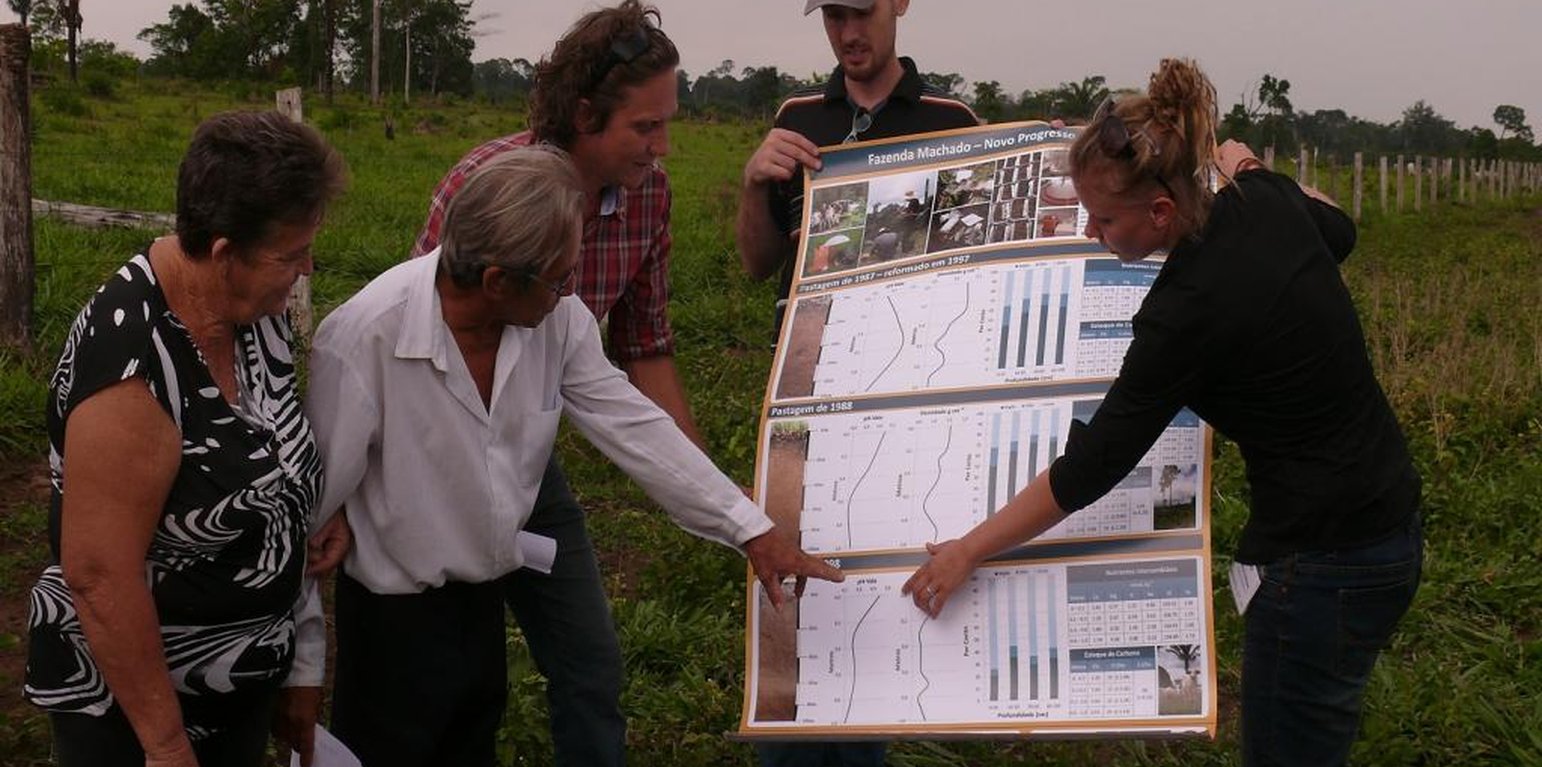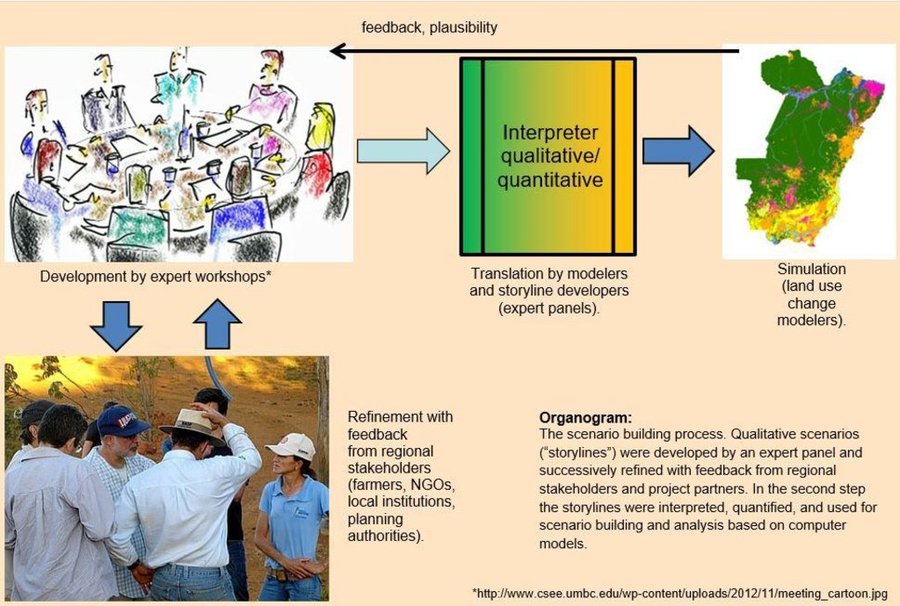From storylines to scenarios: raising awareness and decision support
(Бразил)
Тодорхойлолт
Investigating viable carbon-optimized land management strategies, which maintain or improve ecosystem function, under changing climate conditions in the Southern Amazon - using regional scenarios generated from storylines.
Aims / objectives: One objective of the Carbiocial project, in close cooperation with its Brazilian partner project Carbioma, is to explore how land use change in one of Brazil’s most dynamic regions will develop in the next 30 years and how it will be affected by the implementation of land-use planning options and conservation policies. For this purpose a set of scenarios was created. The scenarios portray different plausible development pathways for the region. Each scenario consists of a storyline: a brief narrative of the future. At this level farmers and institutions are involved. An expert panel translated the findings of several stakeholder workshops and extensive stakeholder and expert interviews, conducted in 2012, into qualitative information needed to elaborate these scenarios. Four storylines emerged: (1) “business-as-usual”; (2) sustainable, extensive use of the Amazon; (3) legal intensification; (3) illegal intensification.
Methods: It was agreed that the communication between qualitative social science data and quantitative data had to be considered carefully. A blend of the required input factors for the models was agreed as guiding principles for all storylines: these were: population, agrarian production, livestock, agrarian and environmental policies, protected areas, infrastructure, impact of climate change (mitigation/adaptation). In a second step, qualitative data had to be added to the models; to limit bias, all available German experts on Southern Amazonia participated in a day-long (and quite controversial) brainstorming session producing content for the four storylines.
After translating the results into Portuguese the outcome was discussed with representatives of government and NGOs to discuss their plausibility and to modify accordingly. The input of local stakeholders was included on the basis of discussions and qualitative interviews. Generally speaking, the feedback loops with Brazilian stakeholders’ happened rather arbitrarily. Participation could have been better if planned more methodically and earlier.
The three hypothetical storylines describe different pathways of future regional development within the two states. Due to the strong linkages of Southern Amazonia to global markets (e.g. exports of soybean and meat) it was necessary to portray this dependency as one important determinant within the scenarios. Also, law enforcement of the existing legal situation was considered: more than 40% of Amazônia comprises protected areas. In order to portray the possibility of progressive environmental and indigenous legislation, a vibrant civil society, and well-institutionalized public prosecutors, a sustainability scenario was designed.
The next step was the quantification of the qualitative information to facilitate a simulation-based scenario analysis. Simulation models will be combined as software packages to support the decision-taking process from local to landscape and regional scale. All research and implementation activities include direct involvement of the stakeholders. Field experiments for improving C storage and ecosystem function will be performed in cooperation with an NGO founded by the farmers of Mato Grosso.
Other important information: A set of land use maps was generated to depict scenarios from 2010 to 2030. The objective of this modelling and mapping exercise is to support decision-makers to better interpret the scenarios and their implications. These new layers of information will facilitate further model or GIS-based analysis of land use change impacts on the regional carbon balance and the loss of biodiversity, and may act as a test-bed for the development of strategies towards sustainable land management.
Байршил
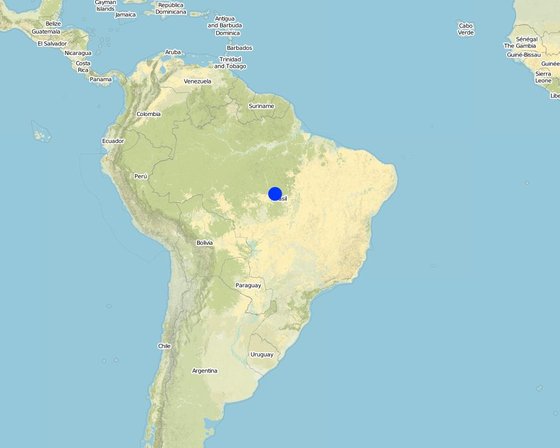
Байршил: Mato Grosso/Pará, Brazil, Бразил
Сонгосон байршлуудын газарзүйн холболт
Эхлэх огноо: 2011
Төгсөх жил: 2016
Арга барилын төрөл
-
уламжлалт / уугуул
-
Сүүлийн үеийн орон нутгийн санаачлага / шинэчлэл
-
төсөл / хөтөлбөр дээр үндэслэсэн
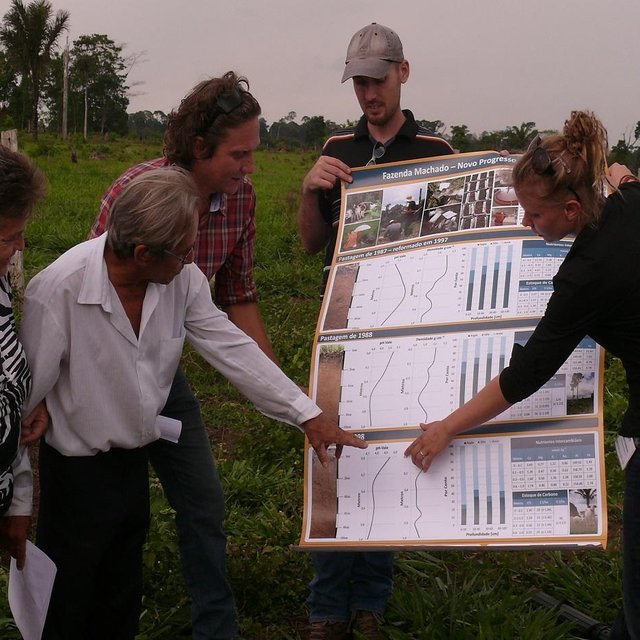
Discussing results with land users to raise awareness (Stefan Hohnwald)
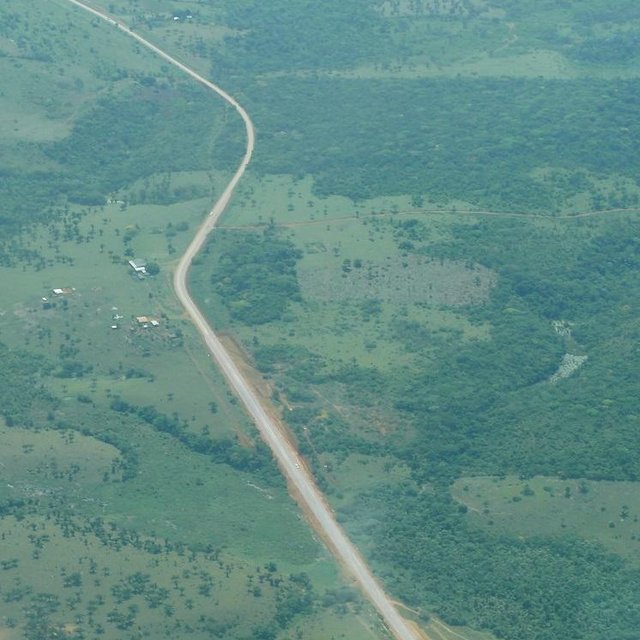
Land use system along Route BR 163 (Stefan Hohnwald)
Арга барилын зорилго ба эерэг нөлөө
Арга барилын үндсэн зорилго, зорилт
The Approach focused mainly on other activities than SLM (carbon-optimized land management)
The joint main goals are 1) to perform region-specific analyses in order to improve and apply interdisciplinary sets of models of land use impacts on carbon stocks, water and GHG balances, 2) to develop and optimize land management strategies that minimize carbon losses and GHG emissions, and maximize carbon sequestration, 3) to assess the trade-offs between land management options and socio-economic impacts in terms of GHG reduction, profitability, ecological sustainability, and last but not least, 4) to support the Brazilian partners to implement the optimal techniques in practice, considering the soybean value chain and overall carbon balance.
The SLM Approach addressed the following problems: High loss of vegetative and soil carbon due to agricultural expansion (deforestation), agricultural emissions, biodiversity loss.
Тухайн Арга барилын хүрээнд нэвтрүүлсэн Технологийг хэрэгжүүлэхэд дэмжлэг болох нөхцлүүд
Тухайн Арга барилын хүрээнд нэвтрүүлсэн Технологийг хэрэгжүүлэхэд хүндрэл учруулах нөхцлүүд
-
Нийгэм / соёл / шашны хэм хэмжээ, үнэт зүйлс: Acceptance of research results
Treatment through the SLM Approach: Dissemination of research results in the form of policy briefs (short graphical illustration of results) and “output-stick” (USB stick with more detailed research results).
-
Хууль, эрхзүйн хүрээ (газар эзэмшил, газар, ус ашиглах эрх): Land tenure
Treatment through the SLM Approach: None
The existing land ownership, land use rights / water rights greatly hindered the approach implementation Especially in Pará, land tenure rights are uncertain and lead to land speculation with resultant land degradation and deforestation.
Талуудын оролцоо ба үүрэг
Арга барилд оролцогч талууд болон тэдгээрийн үүрэг
| Ямар оролцогч талууд / хэрэгжүүлэгч байгууллагууд арга барилд оролцож байсан бэ? |
Оролцогч талуудыг тодорхойлно уу |
Оролцогч талуудын үүргийг тайлбарлана уу |
| Орон нутгийн газар ашиглагч / орон нутгийн иргэд |
|
|
| олон нийтэд түшиглэсэн байгууллагууд |
Indigenous groups were involved in stakeholder workshops with the aim of discussing different storyline options, and in the following feedback loops discussing the resulting storylines. |
|
| ГТМ-ийн мэргэжилтэн/ хөдөө аж ахуйн зөвлөх |
|
|
| Засгийн газар (шийдвэр гаргагч, төлөвлөгч) |
planning authorities |
|
Арга барилын янз бүрийн үе шатанд орон нутгийн газар ашиглагчид / бүлгүүдийг татан оролцуулах
үгүй
идэвхигүй
Гадаад дэмжлэг
интерактив
өөрийн хүчийг нэгтгэсэн
санаачлага/идэвхжүүлэлт
Land users and planning authorities; identification of research priorities, state-of-the-art of agricultural practices, identification of problems.
Research
Research plots for demonstration.
Арга барил хэрэгжүүлэх бүдүүвч
The scenario building process. Qualitative scenarios (“storylines”) were developed by an expert panel and successively refined with feedback from regional stakeholders and project partners. In the second step the storylines were interpreted, quantified, and used for scenario building and analysis based on computer models.
ГТМ-ийн технологи сонгох шийдвэр гаргах явц
Шийдвэр гаргасан этгээд
-
Газар ашиглагч дангаараа (өөрийн санаачлага)
-
ГТМ-ийн мэргэжилтнүүдийн дэмжлэгтэйгээр, голчлон газар ашиглагчид
-
оролцооны зарчмын хэсэг болох бүх холбогдох талууд
-
голдуу ГТМ-ийн мэргэжилтнүүд, газар ашиглагчидтай зөвлөлдсөний үндсэн дээр
-
ГТМ-ийн мэргэжилтэн дангаараа
-
улс төрчид / удирдагчид
Шийдвэр гаргах үндэслэл нь
-
ГТМ-ийн мэдлэгийг баримтжуулалтын үнэлгээ (нотолгоонд суурилсан шийдвэр гаргах)
-
Судалгааны үр дүн, ололтууд
-
Хувь хүний туршлага ба санал бодол (баримтжуулаагүй)
Техникийн туслалцаа, чадавхи бий болгох болон мэдлэгийн менежмент
Дараах үйл ажиллагаа эсвэл үйлчилгээ нь арга барилын нэг хэсэг болсон
-
Чадавхи бэхжүүлэх/сургалт
-
Зөвлөх үйлчилгээ
-
Институцийг бэхжүүлэх (байгууллагын хөгжил)
-
Мониторинг ба үнэлгээ
-
Судалгаа
Чадавхи бэхжүүлэх / сургалт
Дараах сонирхогч талуудад сургалт хийсэн
-
Газар ашиглагчид
-
хээрийн ажилтан / зөвлөх
Сургалтын хэлбэр
-
Ажил дээр
-
фермерээс -фермер
-
үзүүлэнгийн талбай
-
Олон нийтийн уулзалт
-
курс дамжаа
Хамарсан сэдэв
Training focused on raising awareness of the consequences of “business-as-usual” behavior compared with other scenarios.
Зөвлөх үйлчилгээ
Зөвлөх үйлчилгээ үзүүлсэн
-
Газар ашиглагчийн талбай дээр
-
Тогтмол төвд
Name of method used for advisory service: dissemination of research results in the form of policy briefs and more detailed “output sticks”
Advisory service is quite adequate to ensure the continuation of land conservation activities
Мониторинг ба үнэлгээ
bio-physical aspects were ad hoc monitored by project staff through observations
bio-physical aspects were ad hoc monitored by project staff through measurements
socio-cultural aspects were ad hoc monitored by project staff through observations
socio-cultural aspects were ad hoc monitored by project staff through measurements
There were few changes in the Approach as a result of monitoring and evaluation: Dissemination; form of dissemination was adjusted according to the requirements of target groups.
There were no changes in the Technology as a result of monitoring and evaluation
Судалгаа
Судалгаа нь дараах сэдвийг хамарсан
-
Социологи
-
Эдийн засаг/ зах зээл
-
Экологи
-
Технологи
Research was carried out both on station and on-farm
Санхүүжилт болон хөндлөнгийн материаллаг дэмжлэг
ГТМ-ийн бүрэлдэхүүн хэсгийн жилийн төсөв ам.доллараар
-
< 2,000
-
2,000-10,000
-
10,000-100,000
-
100,000-1,000,000
-
> 1,000,000
Precise annual budget: тодорхойгүй
Approach costs were met by the following donors: international (German Ministry of Education and Research BMBF): 100.0%
Газар ашиглагч нарт дараах урамшуулал, үйлчилгээг үзүүлсэн
-
Газар ашиглагчдад санхүүгийн / материаллаг дэмжлэг үзүүлсэн
-
Тодорхой хөрөнгө оруулалтанд нөхөн олговор олгох
-
Кредит
-
Бусад урамшуулал, хэрэгсэл
Нөлөөллийн дүн шинжилгээ ба дүгнэлт
Арга барилын үр нөлөө
Үгүй
Тийм, бага зэрэг
Тийм, зарим
Тийм, их
Арга барил нь ГТМ-ийн технологийг хэрэгжүүлж, хадгалахад газар ашиглагчдад тусласан уу?
Identification of method of applying organic matter to soil; identification of kind of agriculture most suitable for specific region/area; type of crop sown; crop sowing dates; economic return/economic optimization.
Арга барил нь эмзэг бүлгийнхнийг нийгэм, эдийн засгийн хувьд чадавхижуулсан уу?
Арга барил нь ГТМ-ийн технологийг хэрэгжүүлэхэд саад учруулсан газрын эзэмшил / ашиглах эрхийг сайжруулахад чиглэсэн үү?
Research had no effect on land tenure; research was not aimed at solving the problem, rather research helped to identify the problem.
The problem is likely to be overcome in the near future. reforms of land tenure rights underway
Did other land users / projects adopt the Approach?
Газар ашиглагчид ГТМ хэрэгжүүлэх болсон үндсэн шалтгаан
-
үйлдвэрлэл нэмэгдсэн
-
Ашиг нэмэгдсэн (боломж), зардал-үр ашгийн харьцаа сайжирсан
-
Газрын доройтол буурсан
-
Гамшигийн эрсдэл буурсан
-
Ажлын ачаалал бууруулсан
-
төлбөр / татаас
-
дүрэм журам (торгууль) / сахиулах
-
нэр хүнд, нийгмийн дарамт / нийгмийн холбоо
-
Сүлжээ/ бүлэг төсөл/ хөдөлгөөнд гишүүнээр элсүүлэх
-
Байгаль орчны ухамсар
-
зан заншил, ёс суртахуун
-
ГТМ-ийн мэдлэг, туршлага дээшилсэн
-
гоо зүйн сайжруулалт
-
зөрчилдөөнийг бууруулах
-
well-being and livelihoods improvement
Арга барилын хүрээнд хэрэгжүүлсэн үйл ажиллагааны тогтвортой байдал
Газар ашиглагчид арга барилаар дамжуулан хэрэгжүүлсэн арга хэмжээг тогтвортой үргэлжлүүлж чадах уу (гадны дэмжлэггүйгээр)?
No-till agriculture, crop rotations, recommended sowing dates, expanding agricultural land according to crop yield information, and information regarding negative effects of cropland/rangeland expansion (e.g. soil and site specific GHG emissions) which were identified through the different scenarios.
Дүгнэлт, сургамж
Давуу тал: газар ашиглагчийн бодлоор
Давуу тал: эмхэтгэгч эсвэл бусад мэдээлэл өгсөн хүмүүсийн бодлоор
-
improved choice of crop/crop rotation; more environmental friendly choice of kind of agriculture employed (agroforestry systems); improved awareness of existence and functionality of regulations in favor of sustainability better dissemination; heightened awareness of land users to sustainability topics and environmental degradation
Сул тал/ дутагдал / эрсдэл: газар ашиглагчийн бодлоордаван туулах боломжууд
Сул тал/ дутагдал / эрсдэл: эмхэтгэгч эсвэл бусад мэдээлэл өгсөн хүмүүсийн бодлоордаван туулах боломжууд
-
Acceptance of results by famers, planning authorities, decision makers in general (political level).
Суурь мэдээлэлүүд
Хянагч
-
David Streiff
-
Deborah Niggli
Баримтжуулсан огноо: 09 6-р сар 2016
Сүүлийн шинэчлэл: 04 4-р сар 2018
Мэдээлэл өгсөн хүн
-
Jan Goepel (goepel@cesr.de) - ГТМ мэргэжилтэн
-
Stefan Hohnwald (shohnwa@gwdg.de) - ГТМ мэргэжилтэн
-
Juliana Gil (julianagil@uol.com.br) - ГТМ мэргэжилтэн
-
Georg Guggenberger - None
-
Michael Klingler - ГТМ мэргэжилтэн
-
Tobia Lakes - ГТМ мэргэжилтэн
-
Jürgen Böhner - ГТМ мэргэжилтэн
-
Rüdiger Schaldach - ГТМ мэргэжилтэн
-
Matthias Siebold - ГТМ мэргэжилтэн
-
Claas Nendel - ГТМ мэргэжилтэн
-
Regine Schönenberg - ГТМ мэргэжилтэн
-
Gerhard Gerold - ГТМ мэргэжилтэн
WOCAT мэдээллийн сан дахь бүрэн тодорхойлолт
Баримтжуулалтыг зохион байгуулсан
Байгууллага
- Georg August Universität Göttingen (Georg August Universität Göttingen) - Герман
- Humboldt Universität zu Berlin (HU Berlin) - Герман
- Leibniz Institute for Regional Geography (IfL) - Герман
- Universität Hamburg (UHH) - Герман
- Universität Kassel - Герман
Төсөл
- Book project: Making sense of research for sustainable land management (GLUES)
- Carbon optimized land management strategies for southern Amazonia (CARBIOCIAL / GLUES)
Гол сурвалж баримт сэлт
-
J. Goepel et al. (2016) Future scenarios of land-use and land-cover change in Southern Amazonia and resultant greenhouse gas emissions from agricultural soils, to be published in Regional Environmental Change Special Issue “Southern Amazonia”,(in review) :
-
Schönenberg et al. (2016)Inter- and transdisciplinary scenario construction to explore future land use options in Southern Amazonia, to be published in Ecology & Society (in review) :
-
R. Schaldach et al. (to be published) A multi-scale modelling framework for the analysis of societal and environmental processes in Southern Amazonian land systems: Lessons learned from the Carbiocial project.:
